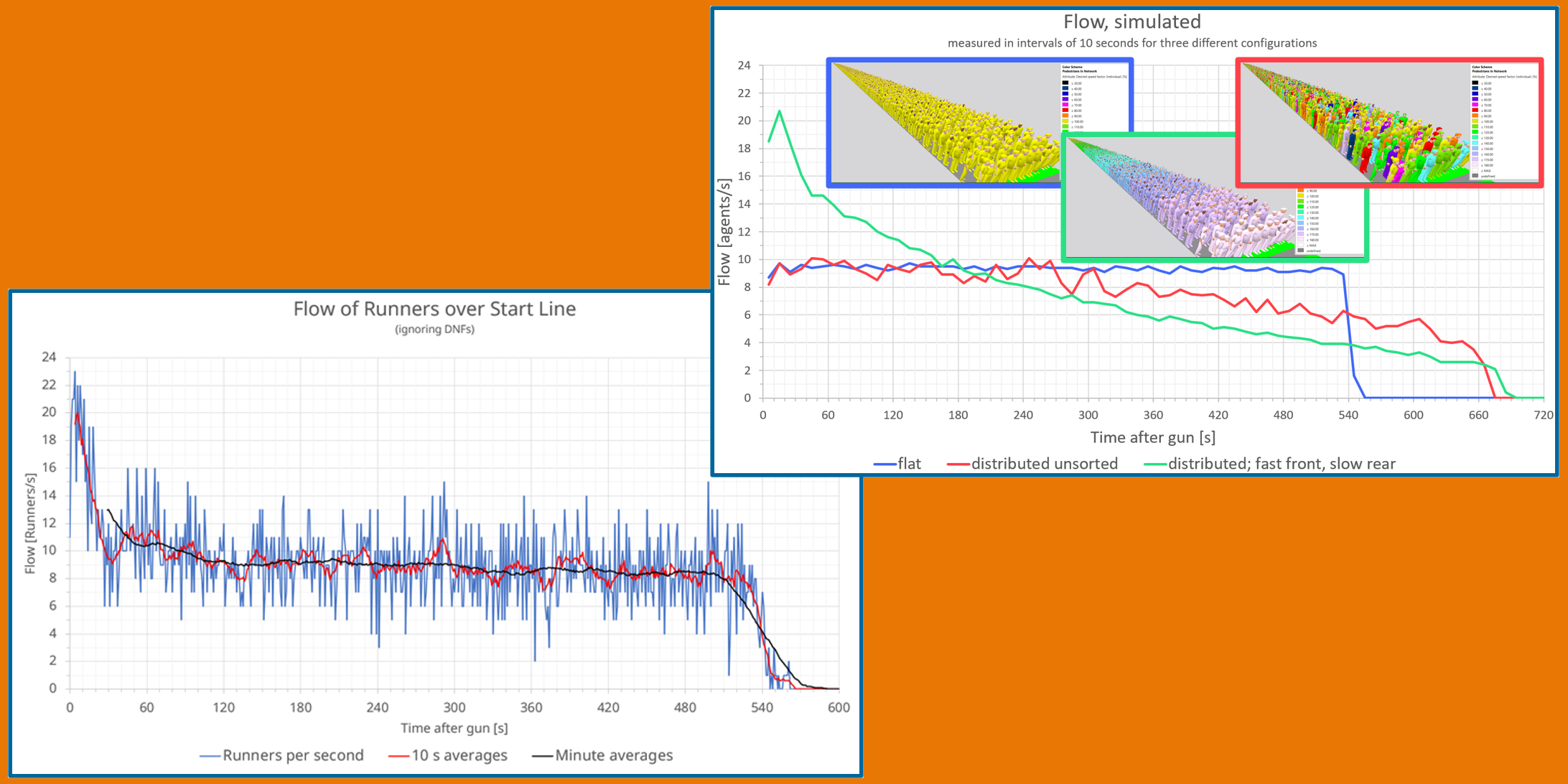What Can Be Learned From (Public) Running Result Data?
DOI:
https://doi.org/10.17815/CD.2024.173Keywords:
Pedestrian flow, Marathon, Fundamental diagram, Social force modelAbstract
Results from running races is available in abundance. In this contribution it is shown, how this data might help to understand pedestrian dynamics in general, as well as the situation at the start and experience for runners.
References
Tomoeda, A., Yanagisawa, D., Imamura, T., Nishinari, K.: Propagation speed of a starting wave in a queue of pedestrians. Physical Review E 86(3), 036113 (2012). doi:10.1103/PhysRevE.86.036113
Rodriguez, E., Espinosa-Paredes, G., Alvarez-Ramirez, J.: Convection-diffusion effects in marathon race dynamics. Physica A: Statistical Mechanics and its Applications 393, 498-507 (2014). doi:10.1016/j.physa.2013.09.051
Treiber, M., Germ, R., Kesting, A.: From drivers to athletes: modeling and simulating cross-country skiing marathons. In: Traffic and Granular Flow'13, pp. 243-249. Springer (2015). doi:10.1007/978-3-319-10629-8_29
Pennisi, A., Bloisi, D.D., Iocchi, L.: Online real-time crowd behavior detection in video sequences. Computer Vision and Image Understanding 144, 166-176 (2016). doi:10.1016/j.cviu.2015.09.010
Bain, N., Bartolo, D.: Dynamic response and hydrodynamics of polarized crowds. Science 363(6422), 46-49 (2019). doi:10.1126/science.aat989
Anagnostopoulos, A.: The rise of run-commuting as a form of transportation: research on the characteristics and spatial needs of these trips. In: Advances in Mobility-as-a-Service Systems: Proceedings of 5th Conference on Sustainable Urban Mobility, Virtual CSUM2020, June 17-19, 2020, Greece, pp. 684-693. Springer (2021). doi:10.1007/978-3-030-61075-3_67
Anagnostopoulos, A.: Designing runnable cities. Transportation Engineering p. 100238 (2024). doi:10.1016/j.treng.2024.100238
MyRaceResult: Fiducia gad baden-marathon karlsruhe. website (2019). https://my.raceresult.com/108997/#1_95459E
Nikitin, P., Rao, K., Lazar, S.: An overview of near field uhf rfid. In: 2007 IEEE international conference on RFID, pp. 167-174. IEEE (2007). doi:10.1109/RFID.2007.346165
Klohr, N.: RACE RESULT :: Tech Deep Dive :: UHF RFID Timing Fundamentals. youtube (2018). https://youtu.be/MCQe3kwb76k
Klohr, N.: race|result tech deep dive: UHF Detection Algorithm. youtube (2018). https://youtu.be/AXjWsJM0sTE
Result, R.: Hardware configurator. website (2023). https://www.raceresult.com/en-us/systems/passive.php
PTV Planung Transport Verkehr GmbH, Haid-und-Neu-Str. 15, D-76131 Karlsruhe: Manual - PTV Vissim 2023 (2023). Section 4.2
Johansson, A., Helbing, D., Shukla, P.: Specification of the social force pedestrian model by evolutionary adjustment to video tracking data. Advances in complex systems 10(supp02), 271-288 (2007). doi:10.1142/S0219525907001355
PTV Group, Karlsruhe: PTV Vissim 2020 Manual (2020)
Kretz, T., Große, A., Hengst, S., Kautzsch, L., Pohlmann, A., Vortisch, P.: Quickest paths in simulations of pedestrians. Advances in Complex Systems 14(05), 733-759 (2011). doi:10.1142/S0219525911003281
Maritime Safety Committee (MSC), S.C.o.F.P.F.: Revised guidelines on evacuation analysis for new and existing passenger ships. Circ 1533, International Maritime Organization (IMO), 4 Albert Embarkment, London, UK (2016)
Schadschneider, A., Klingsch, W., Klupfel, H., Kretz, T., Rogsch, C., Seyfried, A.: Evacuation Dynamics: Empirical Results, Modeling and Applications, pp. 3142-3176. Springer New York (2009). doi:10.1007/978-0-387-30440-3_187
Zhang, J.: Pedestrian fundamental diagrams: Comparative analysis of experiments in different geometries. Dr., Universität Wuppertal, Jülich (2012). URL https://juser.fz-juelich.de/record/128157. Universität Wuppertal, Diss., 2012
Daamen, W., Hoogendoorn, S.: Emergency door capacity: influence of door width, population composition and stress level. Fire technology 48, 55-71 (2012). doi:0.1007/s10694-010-0202-9
Kretz, T.: An overview of fundamental diagrams of pedestrian dynamics (2019). doi:10.13140/RG
Newell, G.: Nonlinear effects in the dynamics of car following. Operations research 9(2), 209-229 (1961). doi:10.1287/opre.9.2.209
Wahle, J., Neubert, L., Esser, J., Schreckenberg, M.: A cellular automaton traffic flow model for online simulation of traffic. Parallel Computing 27(5), 719-735 (2001). doi:10.1016/S0167-8191(00)00085-5
Johansson, A.: Constant-net-time headway as a key mechanism behind pedestrian flow dynamics. Physical review E 80(2), 026120 (2009). doi:10.1103/PhysRevE.80.026120
Greenshields, B., Bibbins, J., Channing, W., Miller, H.: A study of traffic capacity. In: Highway research board proceedings, vol. 14, pp. 448-477. Washington, DC (1935)
Greenberg, H.: An analysis of traffic flow. Operations research 7(1), 79-85 (1959). doi:10.1287/opre.7.1.79
Underwood, R.: Speed, volume and density relationships, in quality and theory of traffic flow. Bur. Highway Traffic, Yale Univ. pp. 141-188 (1961)
Drake, J., Schofer, J., May, A.: A statistical analysis of speed-density hypotheses. Traffic Flow and Transportation (1965)
Weidmann, U.: Transporttechnik der fußgänger: transporttechnische eigenschaften des fußgängerverkehrs. IVT Schriftenreihe 90 (1993). doi:10.3929/ethz-a-000687810
Daganzo, C.: The cell transmission model: A dynamic representation of highway traffic consistent with the hydrodynamic theory. Transportation research part B: methodological 28(4), 269-287 (1994). doi:10.1016/0191-2615(94)90002-7
Van Aerde, M., Rakha, H.: Multivariate calibration of single regime speed-flow-density relationships [road traffic management]. In: Pacific Rim TransTech Conference. 1995 Vehicle Navigation and Information Systems Conference Proceedings. 6th International VNIS. A Ride into the Future, pp. 334-341. IEEE (1995). doi:10.1109/VNIS.1995.518858
Parisi, D., Sartorio, A., Colonnello, J., Garcimartín, A., Pugnaloni, L., Zuriguel, I.: Pedestrian dynamics at the running of the bulls evidence an inaccessible region in the fundamental diagram. Proceedings of the National Academy of Sciences 118(50), e2107827118 (2021). doi:10.1073/pnas.210782711
Johansson, F., Duives, D., Daamen, W., Hoogendoorn, S.: The many roles of the relaxation time parameter in force based models of pedestrian dynamics. Transportation Research Procedia 2, 300-308 (2014). doi:10.1016/j.trpro.2014.09.057
Kretz, T., Eckes, L., Diz, J., Knappik, L., Lipp, D., Müller, S.: Using empirical travel time distributions for calibration of a model of pedestrian dynamics. submitted (2023). Presented as poster 51 at PED 2023.

Downloads
Published
How to Cite
Issue
Section
Categories
License
Copyright (c) 2024 Tobias Kretz

This work is licensed under a Creative Commons Attribution 4.0 International License.
Authors contributing to Collective Dynamics agree to publish their articles under the Creative Commons Attribution 4.0 license.
This license allows:
Share — copy and redistribute the material in any medium or format
Adapt — remix, transform, and build upon the material
for any purpose, even commercially.
The licensor cannot revoke these freedoms as long as you follow the license terms.
Authors retain copyright of their work. They are permitted and encouraged to post items submitted to Collective Dynamics on personal or institutional websites and repositories, prior to and after publication (while providing the bibliographic details of that publication).








